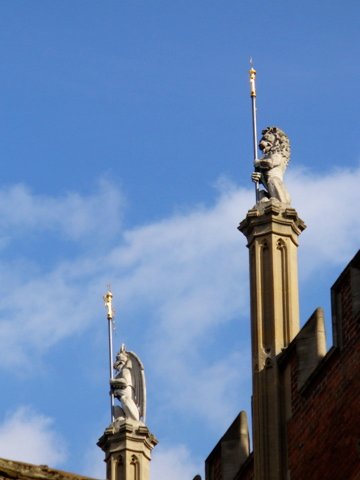
After Newark and Cranwell, I returned to London, for the last couple of weeks of my stay there. No longer did the summer stretch out before me. This meant that I had to start making hard choices about how to spend my time, both in terms of my research and my sight-seeing. In my gawking tourist mode, I still had three major sites on my must-see list — Hampton Court Palace, the Tower of London, and Greenwich — but only two sight-seeing days left! The first of these was the summer bank holiday, which turned out to be a nice day, so I chose to head out to Hampton Court Palace, much of which dates to the 15th century. The present building was originally Cardinal Wolsey’s palace; Henry VIII acquired it through not-entirely-honourable circumstances, and it was a popular royal palace up until the Georgian period.

This is the palace from across the Thames. It’s not the best angle, perhaps, but it does show off the the authentic Tudor car and motor boat in the foreground.

A view of the main gate from the Base Court (i.e., inside the palace), which dates to the second decade of the 16th century, Wolsey’s day.
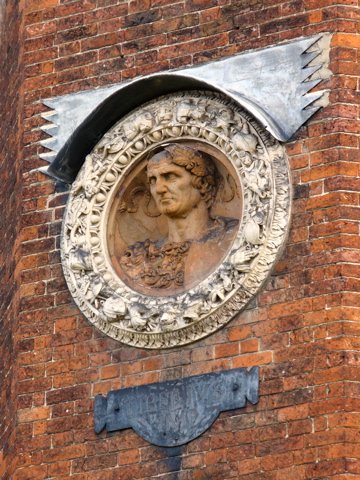
Dotted around the courtyards are terracotta medallions of various Roman emperors. Wolsey commissioned them from Giovanni da Maiano, and, it has been suggested, were basically taken from an Italian guide on palace design for the up-and-coming cardinal. But the selection of emperors seems a bit strange. The one above is Tiberius, whose reputation probably still hasn’t recovered from Tacitus’s hatchet-job; but I see from Ronald Mellor’s Tacitus (1993) that the Annals wasn’t widely influential in Europe (outside Germany) until a few decades into the 16th century, so perhaps Tiberius isn’t so odd. But, looking through my other photos, there’s a Titus, an Otho and a Nero. Titus I can understand, but Otho ruled for barely three months in AD 69, and Nero was, well, Nero. Now I know that all things classical and pagan were in vogue during the Renaissance, but I wouldn’t have thought that the first persecutor of the Christians would be the obvious emperor for a cardinal to choose!
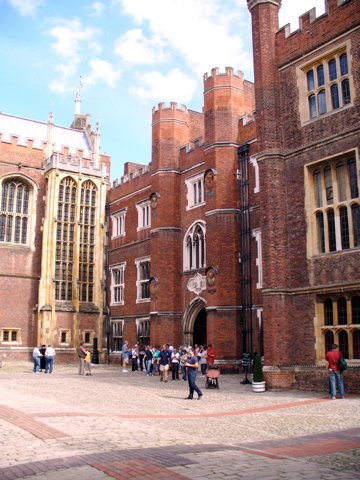
Next court, the Clock Court.

The colonnade on the south side of the Clock Court. As both these photos show, there’s an odd mishmash of architectural styles throughout the palace (the last major changes are ‘restorations’ and additions from Victoria’s reign, including — I think — the lion and the dragon holding up the flagpoles at the start of the post). That’s something I didn’t fully appreciate, knowing only of castles and palaces at a distance — over the centuries, they were often extensively rebuilt by their current owners to suit current needs or fashions. So I don’t think I actually saw an architecturally ‘pure’ castle or palace the whole time I was overseas, unless it was in Rome, perhaps. I suppose the trick is to find somewhere owned by a family which had fallen on hard times for several hundred years, and so didn’t have the money to do it up very often.
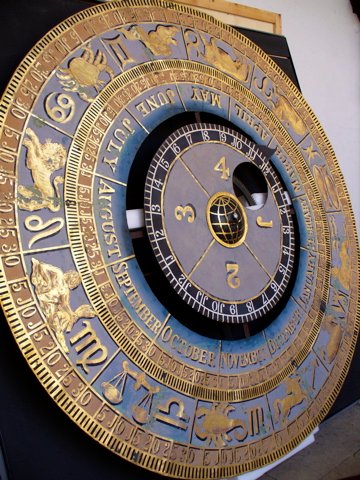
Now this is a real treasure. It’s a 16th century astronomical clock which normally resides over the gateway between the outer Base Court and the inner Clock Court. But the gateway is being restored, so for the time being the clock components are propped up against a wall (as can be seen in the previous photo), so I got to have a good look at them.

This is the clock’s hand, which moves the Sun around the clock’s rim (in the previous photo), which is divided into months and days and the corresponding zodiacal constellations (each 30° wide). So it’s actually a calendar, more than a clock. The big disc would go underneath the black-rimmed central disc in the previous photo — it’s marked to the length of a lunar month (a bit over 29.5 days). The black heart-shape is there to show the phase of the moon as it passes under the hole in the black-rimmed disc.
Well, that’s all perfectly clear in my head, but I’m not so sure that it’s still clear after I’ve written it down …

The clock was constructed in 1540, according to the adjacent sign. However, this site thinks that’s a myth, and that it goes back to at least 1528. (The mechanism above does bear the mark “N.O. 1540”, referring to the Tudors’ clock keeper Nicholas Oursian, but that only dates to the late 19th century.)
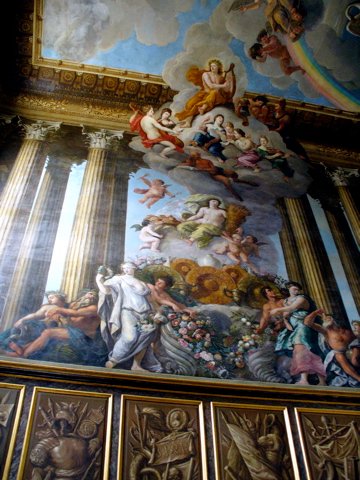
The magnificent, if somewhat over-the-top, paintings in the King’s Staircase, the entrance to the state apartments of William III — that is, a series of increasingly grand rooms by which his subjects approached His Majesty, culminating in the bedroom where he received his closest intimates. Mary II had a similar set of apartments, just as grand (and Henry VIII’s are also still here, somewhat less linearly). No photos allowed inside the palace proper, so you can’t see the Hampton Court Beauties or the grace and favour or King Harry’s Great Hall, unless you visit yourself.

The, erm, staircase in the King’s Staircase. The murals are by Antonio Verrio and depict figures from Roman mythology and history — everybody from Apollo and Aeneas to Julian the Apostate.

Much later, one critic wrote:
The grandiose wall and ceiling paintings of Verrio and Laguerre, however admired in their own day, have lost their vogue, and it is impossible to look at such decorations as those of the King’s Staircase without a certain impatience at the riot of feeble allegory which they present.
That’s the Edwardians for you — I rather liked it.
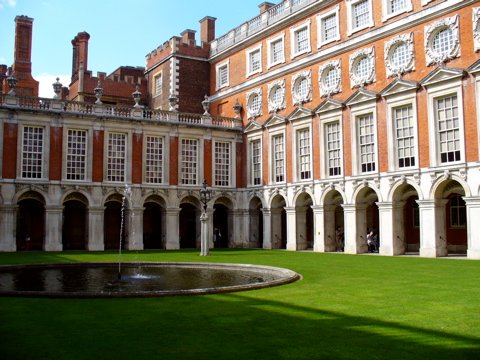
The Fountain Court, designed by the astronomer Christopher Wren.
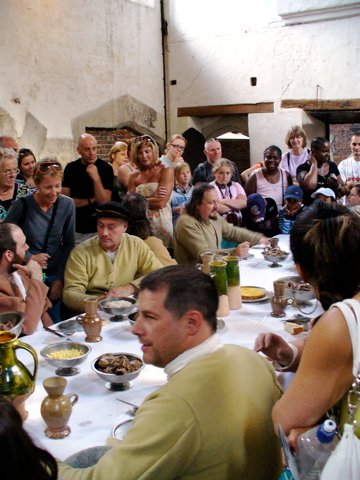
In the Tudor Kitchens with the experimental food historians. This was a highlight of the day (somewhat surprisingly, as I’m not exactly a foodie) — these chaps prepare, cook and ear a meal following the recipes and etiquette of the Tudor period, while one of them gives a running commentary to the crowd. It was most entertaining and educational — the sheer industrial-scale organisation required for feeding a court full of nobles, soldiers, bureaucrats and servants was staggering.

It looked and smelled good … sadly, we were only allowed to look!

I can’t remember what this room is. It’s obviously been restored to reflect some function from the Tudor period — the kitchen accountant, perhaps?

I had no problems navigating the famous maze, being a dedicated follower of walls. But I took a wrong turn when trying to find the entrance to the gardens, so didn’t get to see them before closing time. There’s always next time, I suppose!
Finally, I paused on the bank of the Thames, took a few pictures of the sky, then joined the throngs heading back into town on the train.
![]() This work is licensed under a Creative Commons Attribution-NonCommercial-NoDerivatives 4.0 International License.
Permissions beyond the scope of this license may be available at http://airminded.org/copyright/.
This work is licensed under a Creative Commons Attribution-NonCommercial-NoDerivatives 4.0 International License.
Permissions beyond the scope of this license may be available at http://airminded.org/copyright/.

I was disappointed notto see the Hampton Court Beauties. I saw them in 2001 and was quite taken by several of them, but have not been able to see a photo of them since then Can anyone help me? Sandy Allen
Sorry, I can’t help! For some reason there don’t seem to be any reproductions on the web, even on Hampton Court’s own page.